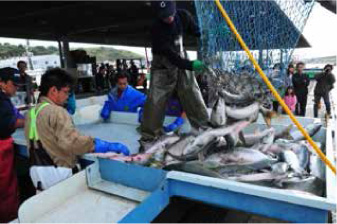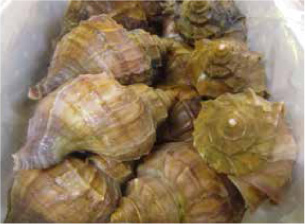5.Living together with the sea
- Theme C:
Learning about and enjoying the symbiosis between humans and nature from history -
- 1. Hokkaido's original inhabitants came from the north
- 2. The hardships of the Ainu people and their restoration as an indigenous community
- 3. Prosperity brought to Hokkaido through distribution routes
- 4. Samani Mountain Path (Hokkaido's first national highway) and Tojuin Temple (one of the Three Temples of Ezo)
- 5.Living together with the sea
- ※Choose the desired content.
The waters off the Hidaka coast are known as a fertile fishing ground where the warm Tsugaru current, which branches off the Tsushima current flowing northward along the Sea of Japan coast, meets the cold Oyashio (or Kuril) current, which flows southward from the eastern side of the Kuril Islands along the eastern coast of Hokkaido. This creates habitats for large communities of salmon, Alaska pollock, squid and other species that are caught off the Samani coast (Mt. Apoi Geopark). As well as being a rich source of octopuses, flounders, sea urchins and whelks, the waters close to the shore also support thriving cultivation of kombu kelp and other types of seaweed.
Samani's fishing industry has a long history. Kombu kelp and salmon have been important products since the Edo period, and were shipped to Honshu by Kitamaebune merchant vessels.

Unloading of chum salmon via fixed-net fishing

Whelks - a premium Samani seafood product
The key product of Samani's fishing industry is Mitsuishi Kombu kelp (Laminaria angustata), which is known as Hidaka Kombu all over Japan. It is renowned for its versatility, being ideal for soup stock and complementing various dishes. From July to September, when kelp harvesting is at its peak, the beaches of Samani teem with activity. Hidaka Kombu is spread out on gravel and sun-dried as soon as it is harvested.
Hidaka Kombu prices depend on the harvesting location. As quality varies significantly with the place of growth and the natural environment of the land nearby, the shores of Hidaka are strictly classified into four quality ranks: extra-high, high, medium and regular. All Samani shores are ranked as high quality, and the only other extra-high and high quality shores are adjacent. The high quality of the local kombu kelp is attributed to the presence of Mt. Apoi and its peridotite, which is rich in iron, magnesium and other minerals. The nutrient-rich water that flows from the mountain into the sea may contribute to the fineness of local kelp.




